How Federal Funding Impacts Environmental and Agricultural Stewardship in Lancaster County
By Tim Stuhldreher in partnership with The Lancaster County Community Foundation
June 3, 2025
Our unique role as a community foundation allows us to hear directly from organizations on the front lines to learn first hand how federal actions are impacting us here in Lancaster County. To help connect our shared community with accurate information, we reached out to a variety of organizations to understand how cuts to federal support may impact residents throughout Lancaster County – and beyond.
Lancaster County is blessed with some of the most attractive and bountiful landscapes to be found anywhere in the world.
Much of the county remains rural, with rolling hills dotted with sun-dappled woods and crisscrossed by meandering streams. About two-thirds of the county is agricultural: There are some 5,000 farms here, almost all family-owned, that generate more than $1.5 billion in annual output, according to the Lancaster County Agriculture Council. The county is first in the U.S. for preserved farmland, and it boasts the world’s largest Amish settlement, one of the main drivers of a $2.7 billion tourism industry.
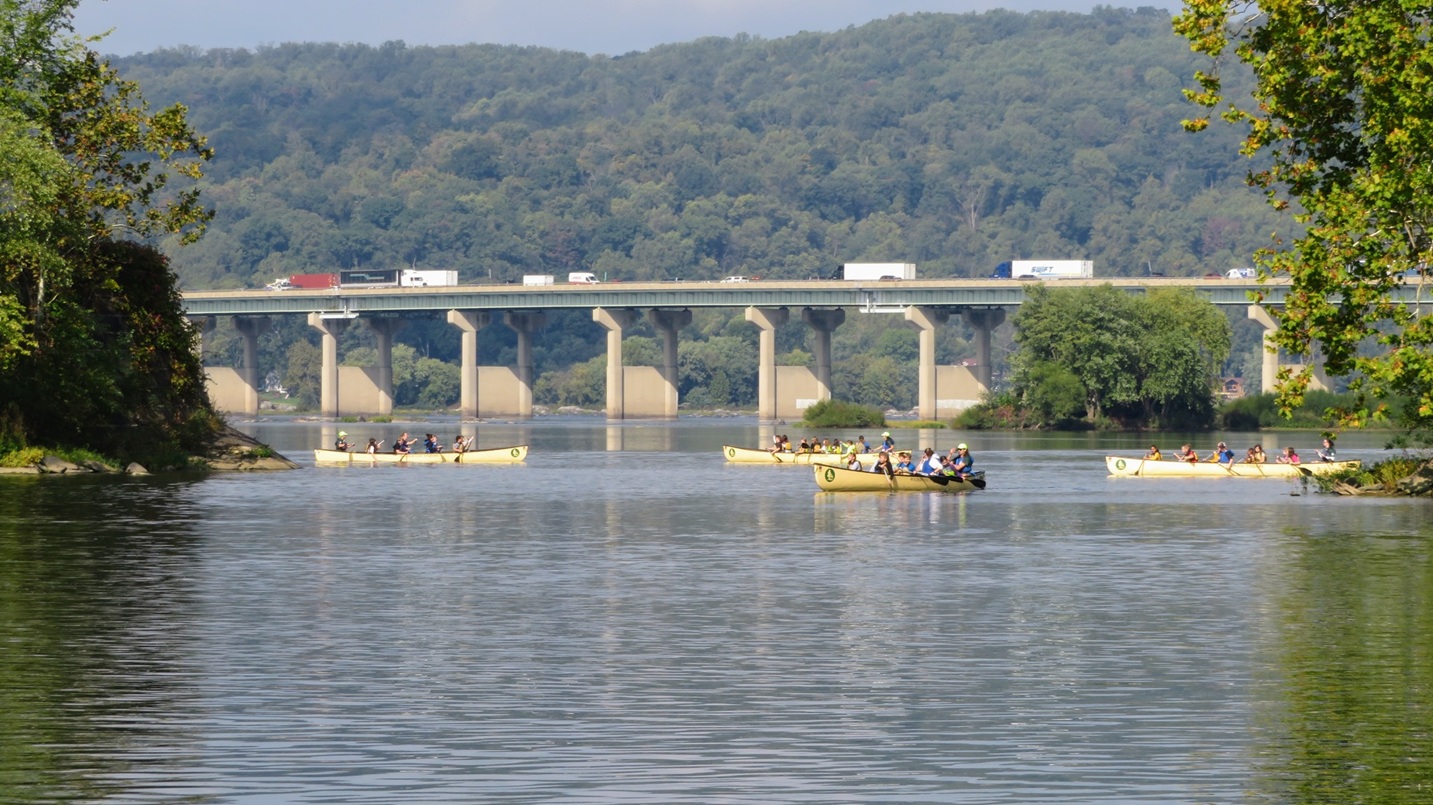
Students from Eastern York School District paddle canoes in the Susquehanna. (Source: Susquehanna National Heritage Area)
Outdoor recreation is burgeoning here, with an ever-growing network of hiking and biking trails and opportunities to kayak, rock climb, go fishing or ride a hot-air balloon.
Numerous organizations — local governments, state and local agencies, nonprofits, private companies — collaborate on environmental initiatives in various ways. Much of their work is undergirded by federal funding, funding that is now at risk. Were it to be curtailed, it would have a significant impact, local nonprofit leaders say.
Is environmental conservation official Lancaster County policy?
Yes, it is. Protecting Lancaster’s natural heritage is key to “Preserving What We Have,” one of the five pillars of Places2040, Lancaster County’s official comprehensive plan adopted in 2018.
The plan calls for continuing farmland preservation efforts; improving the health of rivers and streams and linking natural areas together to create greenways and increase plant and animal habitat. It quotes former President George W. Bush: “Good stewardship of the environment is not just a personal responsibility, it is a public value. … Our duty is to use the land well, and sometimes not to use it at all.”
Prioritizing stewardship isn’t sentimental, Places2040 says. It’s good business sense, sustaining tourism and a high quality of life that makes the area attractive to prospective employers.
How are nonprofits advancing Lancaster County’s environmental goals?
In dozens of ways large and small. Here are three examples:
Clean & clear waters
Lancaster County has more than 1,400 miles of streams. The majority are impaired — polluted by sediment and “nutrients,” mainly nitrogen and phosphorus, from agricultural and urban stormwater runoff and spillover from antiquated sewer and wastewater treatment systems. Nutrients stimulate algae growth and stunt healthy aquatic life, both here and downstream in the Chesapeake Bay.
Lancaster Clean Water Partners is a coalition of organizations working to change that, with the goal of making Lancaster County’s streams “clean and clear by 2040.” Clean Water Partners has more than 70 member entities, based here and throughout the bay watershed. More than 40% are nonprofits.
As a rough estimate, there currently is at least $20 million to $25 million in federal funding “at work on the ground” supporting clean water efforts in Lancaster County, said Allyson Gibson, executive director of Lancaster Clean Water Partners.
It’s hard to be more precise, because there are numerous funding streams and the details are complex. Some federal programs provide money directly; in other cases, federal dollars are channeled through state government or come in the form of a tax credit. Beneficiaries can be public or private. They can be a nonprofit, a commercial enterprise or an ordinary homeowner.
A significant portion of the total flows through the Lancaster County Conservation District, a county-affiliated agency charged with overseeing environmental efforts. As of 2025, it is overseeing 42 state and federal funding streams totaling a little more than $18 million, Manager Christopher Thompson said.
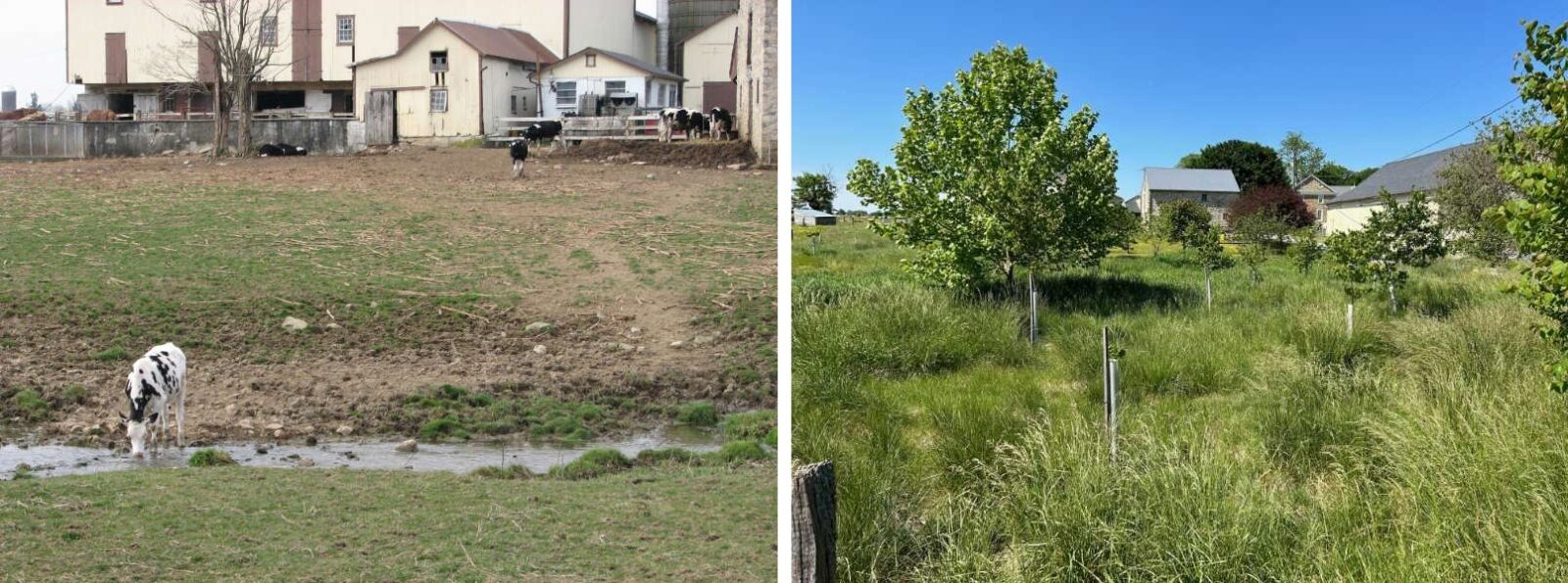
Before and after photos of a riparian buffer and fencing project on a farm in Ronks, PA. The photos were taken seven years apart. (Source: Stroud Water Research Center)
Among other things, state and federal funds help to pay for “best management practices,” or BMPs — interventions to reduce nutrient and stormwater runoff, such as manure management facilities and planting trees and shrubs along streams. Lancaster County is a leader in this work: Of the BMPs placed in Pennsylvania’s portion of the Chesapeake Bay watershed in 2024, more than a quarter were installed here.
Without funding, it would be challenging for farmers and other landowners to afford the projects. Moreover, they are not the only beneficiaries: The BMPs on their land yield cleaner water for everyone downstream, a “positive externality” to use a term from economics. Thanks in part to work in Lancaster County, the 2024 Chesapeake Bay & Watershed Report Card gave the bay its highest grade in more than 20 years.
Sustainable agriculture
Pasa Sustainable Agriculture, is an education, research, advocacy and consulting nonprofit. It works with farmers in 15 Eastern Seaboard states to develop environmentally sound and economically sustainable practices.
Under the Biden administration, Pasa received $59.5 million through the U.S. Department of Agriculture’s Climate Smart Commodities program to help farmers reduce agricultural carbon emissions in 15 states. The funding came from the Inflation Reduction Act, or IRA, the most ambitious climate legislation in U.S. history.
As of this spring, 14 Lancaster County farmers were on board, and were in line for up to $630,000 in federal funding. Pasa was planning to enroll another 16 or so in coming months, Pasa Executive Director Hannah Smith-Brubaker said.
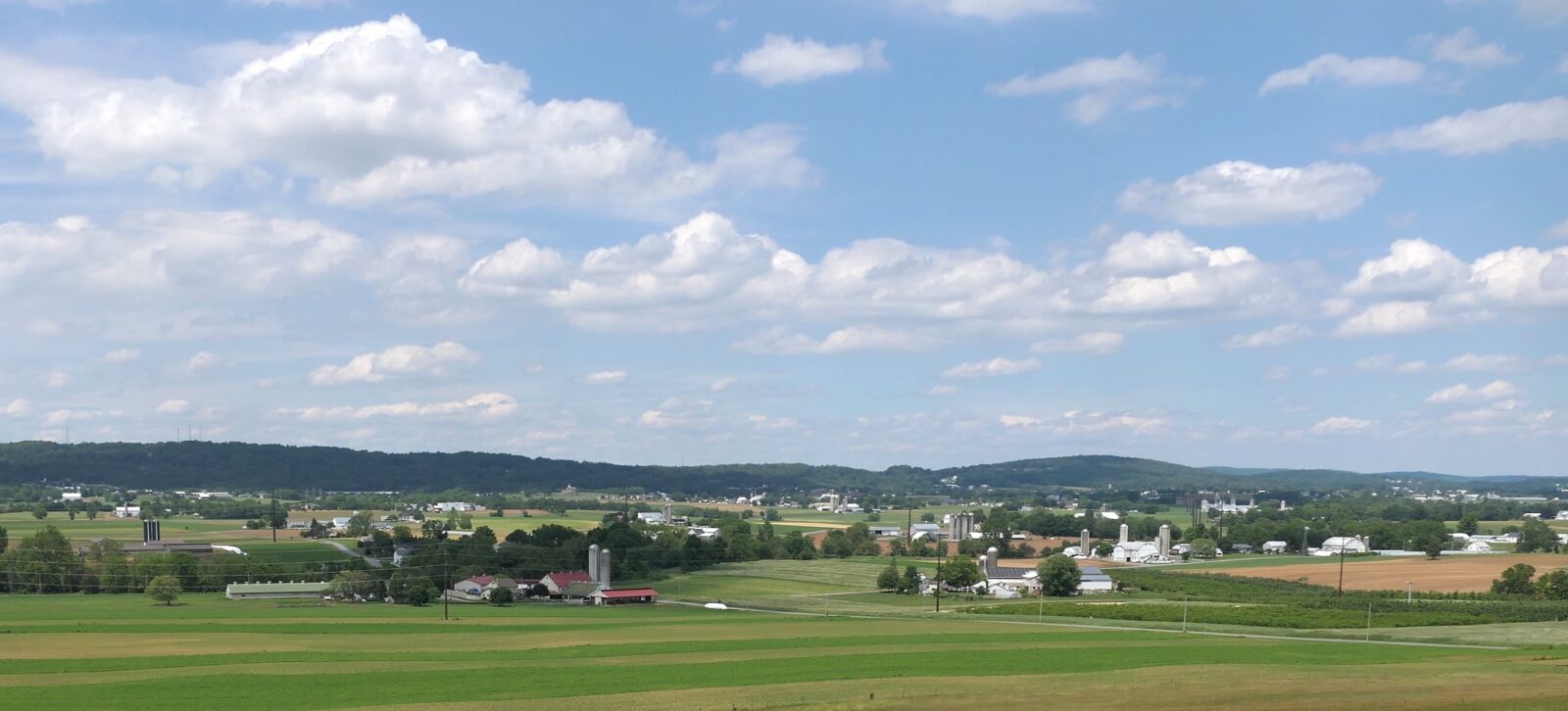
Farmland in West Earl Township. (Source: Tim Stuhldreher)
Clean energy
RegenAll is a local nonprofit that works with businesses, government and homeowners to implement climate solutions. It hosts annual climate summits to build public awareness and has launched a community climate fund to encourage local investing in carbon reduction efforts.
In 2024, RegenAll launched “Energize Lancaster,” an initiative to help households reduce their energy use and shift to clean energy sources. The game plan includes training volunteer energy consultants and providing referrals to qualified contractors and sources of low-cost funding. (Editor’s note: The Lancaster County Community Foundation supported the launch of Energize Lancaster with a $50,000 Shaping Tomorrow grant.)
RegenAll was anticipating being able to help clients of Energize Lancaster access incentives provided by the IRA, President Eric Sauder said. The law provides for generous rebates for a variety of residential renovations and upgrades, including insulation, converting building systems to electricity and installing energy-efficient appliances.
How are federal policy changes affecting these initiatives?
In January 2025, a series of executive orders broadly freezing federal loan and grant programs were issued.
The freeze included several environmental grants administered by the Lancaster County Conservation District, Thompson said.
The district uses the grants to reimburse sub-grantees with which it contracts. Many are Lancaster Clean Water Partners members.
The district initially told them it would temporarily hold off on making payments, but asked them to keep working. Meanwhile, it reached out to its state and federal partners for guidance and clarification, Thompson said.
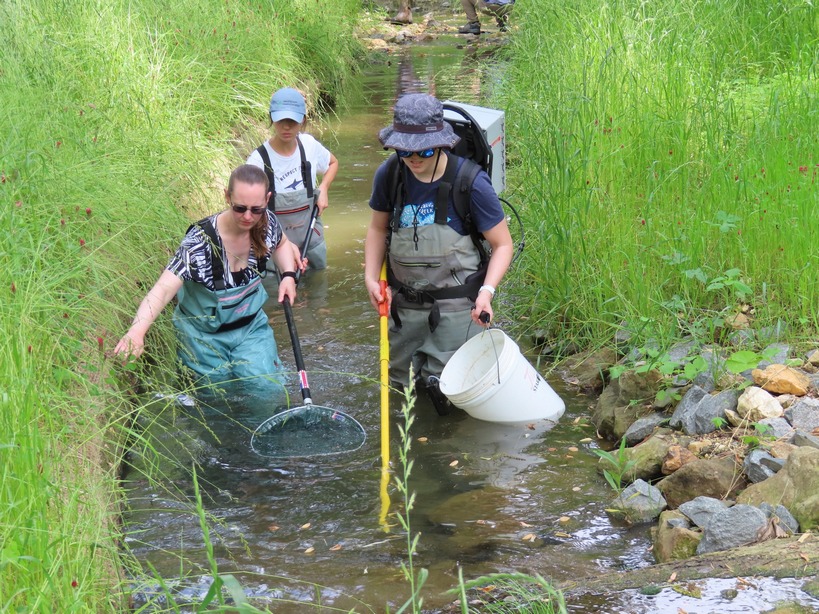
A water quality monitoring team at Shiprock Nature Preserve collects data in a stream. (Source: Lancaster Clean Water Partners)
A few weeks later, following a lawsuit filed by Gov. Josh Shapiro, the federal funding was restored. That development, along with reassurances from the district’s state agency partners, gave it the certainty it needed to resume accepting and processing sub-grantee invoices.
So far, “the money’s still flowing,” Thompson said. Looking ahead, however, “there’s still a tremendous amount of concern.”
Gibson concurred. There’s a new level of uncertainty for front-line organizations: They no longer know if existing funding agreements are valid, or if the administration will unilaterally seek to change or cancel them.
“We acknowledge these are unprecedented times,” she said on “Clean Water Conversations” during a March 14 podcast devoted to the freeze. She encouraged organizations to support each other and noted they have overcome previous challenges, such as the Covid pandemic.
In limbo: Climate Smart Commodities
The dozens of environmental grant programs affected by the freeze included Climate Smart Commodities. Agriculture Secretary Brooke Rollins said the USDA was reviewing its outlays in the course of returning to its “core mission.”
Pasa said it had to furlough some 60 of its 82 employees as a “direct consequence” of the government’s action, and that it was left with $3 million in outstanding reimbursements. In March, the organization joined other plaintiffs in filing a lawsuit challenging the freeze.
On May 19, a judge said he would order the Trump administration to restore 32 of 38 grants. The other six involved the Climate Smart program; their future remained up in the air as of late May.
Pasa has received some of what it’s owed, and has been promised full repayment, but $1.7 million remains outstanding, Smith-Brubaker said.
While USDA is rolling out a replacement program, “Advanced Marketing for Producers,” it is not allowing the existing Climate Smart Commodities program to proceed. That’s frustrating, Smith-Brubaker said: “The farmers were counting on these dollars.”
The Climate Smart projects weren’t anything outlandish, she said; they used well-established practices and involved things like improving farmlands’ capacity to absorb stormwater and retain topsoil. In a statement, Pasa said they employ local vendors and small businesses, bolstering rural economies; and by improving resilience to adverse weather events, they increase food security and contribute to stable food prices.
Pasa’s clients are often skeptical of the USDA, and the freeze has undone much of the trust Pasa had painstakingly built over years, Smith-Brubaker said.
Nullifying the Inflation Reduction Act
On May 22, the U.S. House passed the “One Big Beautiful Bill.” Among its many provisions, it ends tax credits in the Inflation Reduction Act that RegenAll was counting on for Energize Lancaster.
Conservatives have assailed the IRA as a wasteful boondoggle. The Cato Institute called it “an overwhelming and undue burden on taxpayers” that showers money on favored private firms “under the guise of capitalism.”
Environmental proponents disagree. They say the IRA was an important step in modernizing America’s energy system and reducing emissions, and they accuse the law’s critics of toting up the costs without counting the benefits. The Yale Center for Climate Communication contends the IRA would pay for itself many times over in reduced health and climate impacts, economic development and job creation.
Losing the IRA incentives would be a shame, Sauder said. The median low-income household spends 8.3% of its income on energy; a quarter of low-income households spend more than 15%. Upgrades like weatherization and new appliances could significantly reduce their ongoing costs, but it’s usually difficult if not impossible for them to shoulder the up-front costs.
How do Lancaster County nonprofits plan to adjust?
Local leaders said they’ll look for alternative sources of funding. In some cases, projects may be delayed, or perhaps scaled back.
Lancaster Clean Water Partners will find a way to pursue its work one way or another, with or without federal funding, Gibson said.
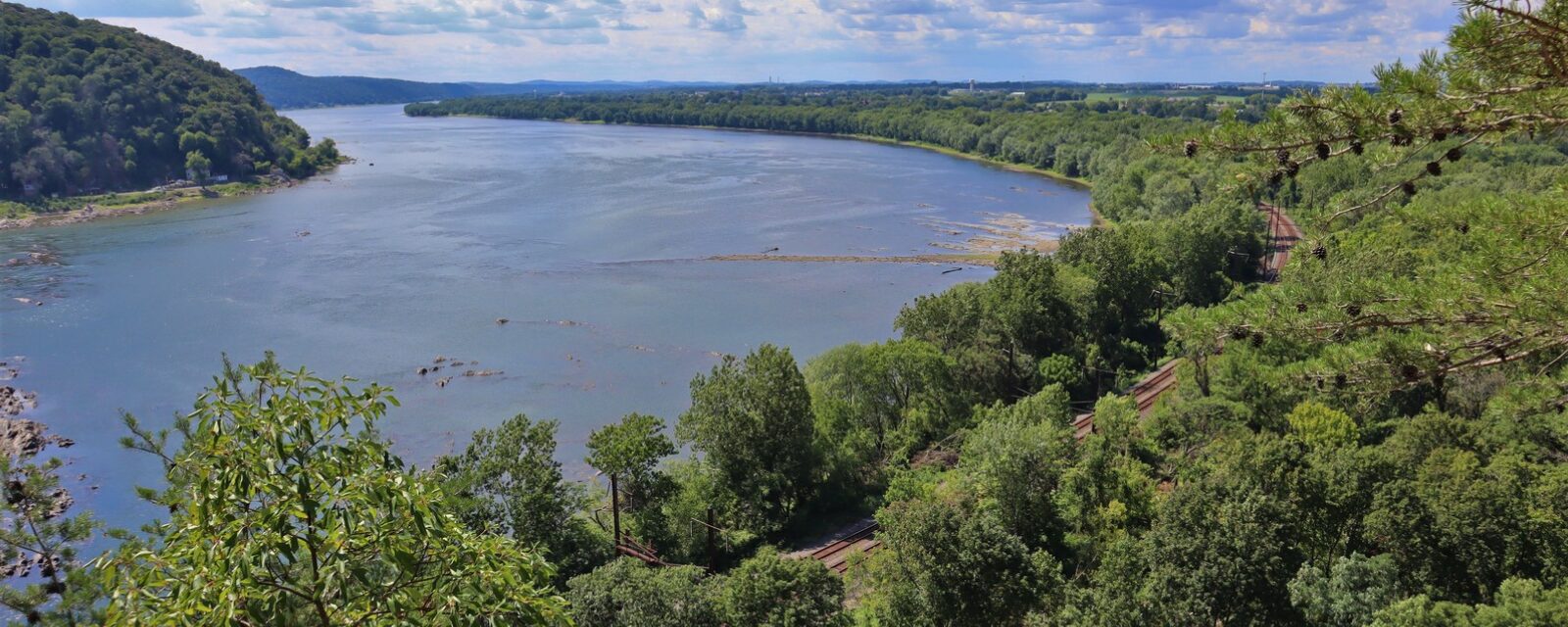
A View of the Susquehanna from Chickies Rock Overlook. (Photo: Tim Stuhldreher)
Clean water infrastructure is expensive and multifaceted. Stream restoration projects can cost millions of dollars. The sewer upgrades that municipalities need to make are even more expensive. Federal aid can go a long way to offset those costs, and if it’s curtailed, “it would have a major impact,” she said.
She cited one encouraging development: Pennsylvania’s Clean Streams Fund. Created in 2022-23 with $220 million in federal American Rescue Plan Act funding, it supports a robust program to build out agricultural BMPs.
In the 2024-25 state budget, the fund received $50 million. The provision was championed by state Sens. Scott Martin, R-Lancaster, and Gene Yaw, a Republican who represents five Northern Tier counties, and the infusion is intended to recur annually.
Federal Action, Local Impact
Connecting our shared community with accurate information about recent federal funding cuts by compiling stories and data from a variety of sources.
Lancaster Clean Water Partners
Curious about what some environmental stewardship projects are doing throughout the county? Check out some recent grants awarded by Lancaster Clean Water Partners.
